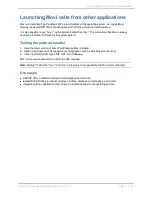
Running the client
Cisco TelePresence Movi Administrator Guide (4.1)
Page 21 of 29
Running the client
Movi is designed to be straight forward and easy to use, but as a highly versatile tool it also has many
hidden configurations and features of use to the administrator. This section details these options so that
you as an administrator will know how to make the most of these features. It also provides an overview
of Movi's communication with the servers, which should help you identify which part of the process to
troubleshoot if you are having problems with your setup.
Signing in
Movi will attempt to sign in to a Cisco VCS according to its
Advanced
settings, whether pre-configured
or provided manually. The sign-in stages are described below.
Subscribing to the Cisco VCS
Movi first attempts to subscribe to the internal Cisco VCS configured in its Advanced settings. If this
fails, for example because the user’s computer is connected to the public internet, Movi will try to
subscribe to the external Cisco VCS.
However, if the internal Cisco VCS is a DNS address that translates to more than one IP address, Movi
will attempt to connect to all these IP numbers before trying the external Cisco VCS. If the DNS server
contains SRV records, Movi will adhere to the priority and weight of the IP addresses, otherwise they will
be tried in random order.
Typically, the Cisco VCS or the Cisco TMS Agent will challenge the first subscription message. Movi
will answer this challenge by sending another SUBSCRIBE message with the authentication
information.
After the subscription has been authenticated, the Cisco TMS Agent will send provisioning information to
the Movi client.
Registering to the Cisco VCS
Movi will register to the Cisco VCS according to the provisioning configuration in Cisco TMS; SIP Server
URI or Public SIP Server URI. If this provisioning configuration is identical to the Advanced setting in the
Movi client (recommended), Movi will register to the same Cisco VCS it subscribed to. As long as the
client is registered, the Cisco VCS will know to forward messages to the client.
After initial registration, Movi will continue to send registration messages to the Cisco VCS according to
the Registration expire delta setting under
VCS configuration > Protocols > SIP > Configuration
.
Movi will send the message after 75% of the specified time interval has elapsed.
Movi is registered to the Cisco VCS
After Movi has signed in, a number of tasks are performed continuously.
Presence
The presence status service is provided by the Cisco VCS. Movi publishes its own presence to the
Cisco VCS and subscribes to presence statuses for any contacts stored in its My contacts list.























